高中英语应用文公开课
- 格式:docx
- 大小:14.18 KB
- 文档页数:2
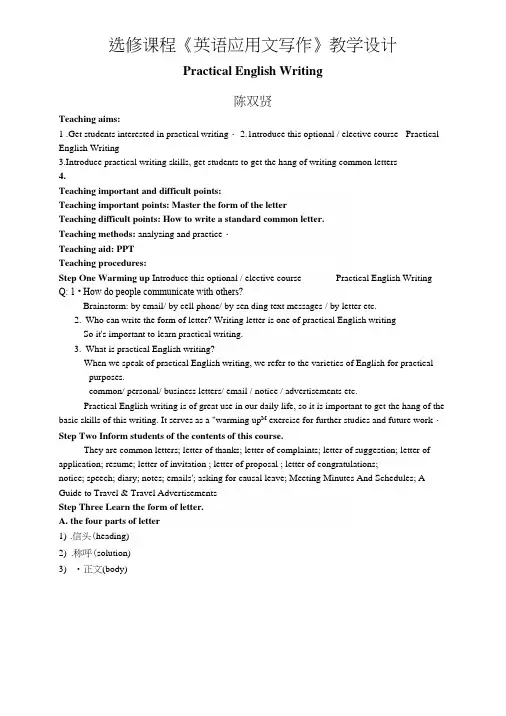
选修课程《英语应用文写作》教学设计Practical English Writing陈双贤Teaching aims:1 .Get students interested in practical writing・ 2.1ntroduce this optional / elective course Practical English Writing3.Introduce practical writing skills, get students to get the hang of writing common letters4.Teaching important and difficult points:Teaching important points: Master the form of the letterTeaching difficult points: How to write a standard common letter.Teaching methods: analysing and practice・Teaching aid: PPTTeaching procedures:Step One Warming up Introduce this optional / elective course---------- Practical English Writing Q: 1 • How do people communicate with others?Brainstorm: by email/ by cell phone/ by sen ding text messages / by letter etc.2.Who can write the form of letter? Writing letter is one of practical English writingSo it's important to learn practical writing.3.What is practical English writing?When we speak of practical English writing, we refer to the varieties of English for practicalpurposes.common/ personal/ business letters/ email / notice / advertisements etc.Practical English writing is of great use in our daily life, so it is important to get the hang of the basic skills of this writing. It serves as a "warming up M exercise for further studies and future work・Step Two Inform students of the contents of this course.They are common letters; letter of thanks; letter of complaints; letter of suggestion; letter of application; resume; letter of invitation ; letter of proposal ; letter of congratulations;notice; speech; diary; notes; emails'; asking for causal leave; Meeting Minutes And Schedules; A Guide to Travel & Travel AdvertisementsStep Three Learn the form of letter.A. the four parts of letter1).信头(heading)2).称呼(solution)3)•正文(body)4).结束语(complimentary close )Xinghua High SchoolBeijing J 02600 ChinaStep. 12,2013President George HopkingsPace Middle SchoolNew York, NY 10038USADear Mr. Hopkings,Yours sincerelyLi Xiuting(President of Xinghua High School)B. writing skills 具体写法1)、信头heading/ letterheadHelp to identify where letters come fromInclude name and address of addresserdate写信人的地址和日期,写在右上角。
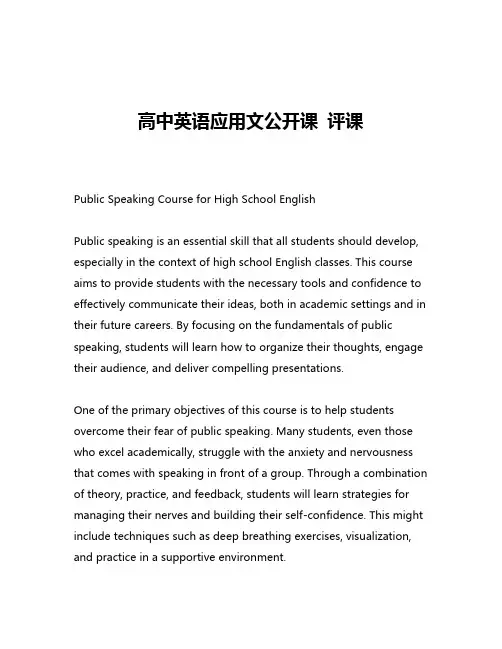
高中英语应用文公开课评课Public Speaking Course for High School EnglishPublic speaking is an essential skill that all students should develop, especially in the context of high school English classes. This course aims to provide students with the necessary tools and confidence to effectively communicate their ideas, both in academic settings and in their future careers. By focusing on the fundamentals of public speaking, students will learn how to organize their thoughts, engage their audience, and deliver compelling presentations.One of the primary objectives of this course is to help students overcome their fear of public speaking. Many students, even those who excel academically, struggle with the anxiety and nervousness that comes with speaking in front of a group. Through a combination of theory, practice, and feedback, students will learn strategies for managing their nerves and building their self-confidence. This might include techniques such as deep breathing exercises, visualization, and practice in a supportive environment.In addition to addressing the emotional and psychological aspects of public speaking, the course will also cover the practical skills necessary for effective communication. Students will learn how to structure a presentation, develop engaging content, and use visual aids to enhance their message. They will practice techniques for making eye contact, using appropriate body language, and projecting their voice with clarity and confidence.One of the key components of the course will be the opportunity for students to deliver multiple presentations throughout the semester. These presentations will cover a variety of topics, from literary analysis to persuasive speeches, allowing students to apply their learning in diverse contexts. Instructors will provide constructive feedback and guidance, helping students to identify their strengths and areas for improvement.In addition to the individual presentations, the course will also incorporate group projects and collaborative activities. This will not only help students develop their teamwork and leadership skills, but also expose them to different communication styles and approaches. By working with their peers, students will learn to adapt their communication strategies to different audiences and situations.Another important aspect of the course will be the exploration of cultural and linguistic diversity in public speaking. Students willexamine how factors such as gender, ethnicity, and cultural background can influence communication styles and expectations. They will learn to recognize and respect these differences, and develop strategies for communicating effectively in cross-cultural contexts.Throughout the course, students will also have the opportunity to engage with guest speakers and industry professionals. These guest speakers will share their own experiences and insights, providing students with a real-world perspective on the importance of public speaking in various fields. This exposure to diverse perspectives will further enrich the learning experience and help students to see the practical applications of the skills they are developing.In conclusion, the public speaking course for high school English is a valuable addition to the curriculum, providing students with the skills and confidence they need to succeed not only in their academic pursuits, but also in their future careers. By focusing on the fundamentals of effective communication, the course will empower students to express their ideas with clarity, conviction, and impact. As they navigate the challenges of the 21st century, these public speaking skills will be an invaluable asset, enabling them to become confident and effective communicators in a rapidly changing world.。

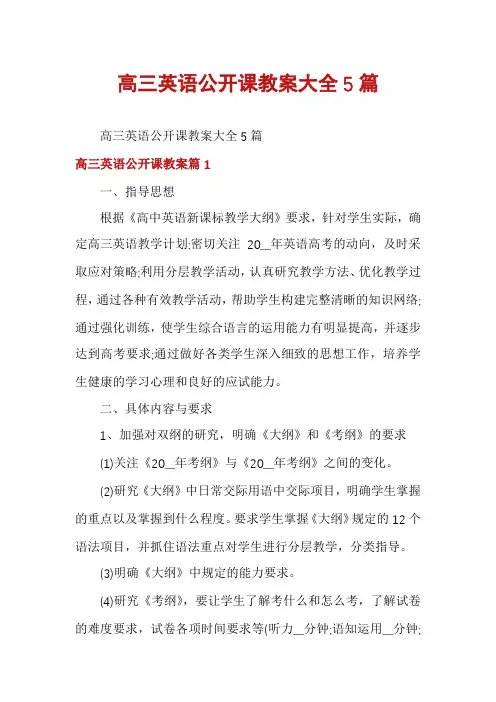
高三英语公开课教案大全5篇高三英语公开课教案大全5篇高三英语公开课教案篇1一、指导思想根据《高中英语新课标教学大纲》要求,针对学生实际,确定高三英语教学计划;密切关注20__年英语高考的动向,及时采取应对策略;利用分层教学活动,认真研究教学方法、优化教学过程,通过各种有效教学活动,帮助学生构建完整清晰的知识网络;通过强化训练,使学生综合语言的运用能力有明显提高,并逐步达到高考要求;通过做好各类学生深入细致的思想工作,培养学生健康的学习心理和良好的应试能力。
二、具体内容与要求1、加强对双纲的研究,明确《大纲》和《考纲》的要求(1)关注《20__年考纲》与《20__年考纲》之间的变化。
(2)研究《大纲》中日常交际用语中交际项目,明确学生掌握的重点以及掌握到什么程度。
要求学生掌握《大纲》规定的12个语法项目,并抓住语法重点对学生进行分层教学,分类指导。
(3)明确《大纲》中规定的能力要求。
(4)研究《考纲》,要让学生了解考什么和怎么考,了解试卷的难度要求,试卷各项时间要求等(听力__分钟;语知运用__分钟;阅读理解x分钟;写x分钟)。
(5)分析20__年高考英语试题(__卷、全国卷),把握考试方向。
2、加强对《大纲》和《考纲》中词汇复习的研究研究《大纲》词汇的内涵和外延度,特别是动词的用法。
优化词汇的教学方法,不能以单词默写来代替词汇训练。
研究学生掌握词汇的状况,在过度教材学习中注意《大纲》词汇的识记和运用,特别是派生词、合成词和多义词等用法的训练,做到词不离句,句不离章。
3、高三英语教材教学(1)要认真扎实地完成高三英语教材选修x的教学任务。
教法上可以将精读和泛读结合起来,目的主要是培养学生英语阅读理解能力。
对课文中的练习可以选择一些重点。
(2)确因教材的难度太大,已不适合作为语言输入的材料,可以选择一些难度相对较低的课文,对学生进行阅读理解的训练。
另外以《20__年高三导与练第一轮英语复习资料》为补充材料,打好学生基础。

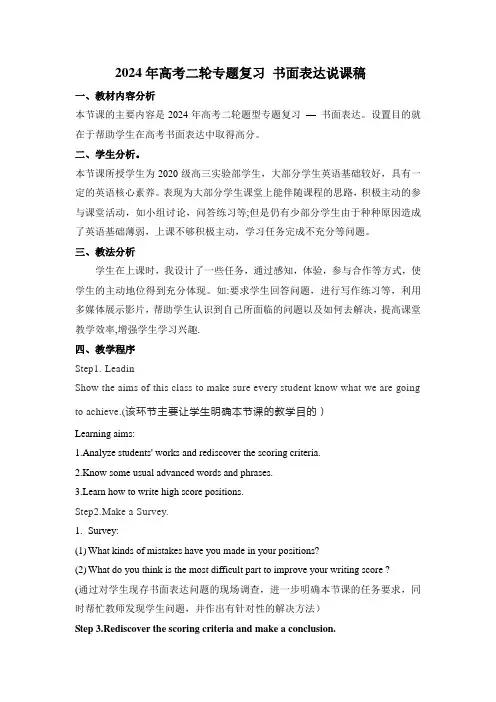
2024年高考二轮专题复习书面表达说课稿一、教材内容分析本节课的主要内容是2024年高考二轮题型专题复习—书面表达。
设置目的就在于帮助学生在高考书面表达中取得高分。
二、学生分析。
本节课所授学生为2020级高三实验部学生,大部分学生英语基础较好,具有一定的英语核心素养。
表现为大部分学生课堂上能伴随课程的思路,积极主动的参与课堂活动,如小组讨论,问答练习等;但是仍有少部分学生由于种种原因造成了英语基础薄弱,上课不够积极主动,学习任务完成不充分等问题。
三、教法分析学生在上课时,我设计了一些任务,通过感知,体验,参与合作等方式,使学生的主动地位得到充分体现。
如:要求学生回答问题,进行写作练习等,利用多媒体展示影片,帮助学生认识到自己所面临的问题以及如何去解决,提高课堂教学效率,增强学生学习兴趣.四、教学程序Step1. LeadinShow the aims of this class to make sure every student know what we are going to achieve.(该环节主要让学生明确本节课的教学目的)Learning aims:1.Analyze students' works and rediscover the scoring criteria.2.Know some usual advanced words and phrases.3.Learn how to write high score positions.Step2.Make a Survey.1.Survey:(1)What kinds of mistakes have you made in your positions?(2)What do you think is the most difficult part to improve your writing score ?(通过对学生现存书面表达问题的现场调查,进一步明确本节课的任务要求,同时帮忙教师发现学生问题,并作出有针对性的解决方法)Step 3.Rediscover the scoring criteria and make a conclusion.高考作文评分原则:第五档(2125分)完全完成了试题规定的任务。
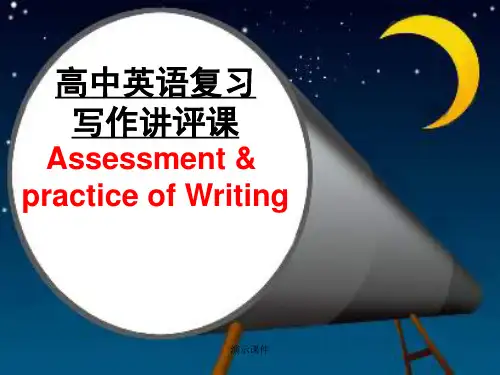


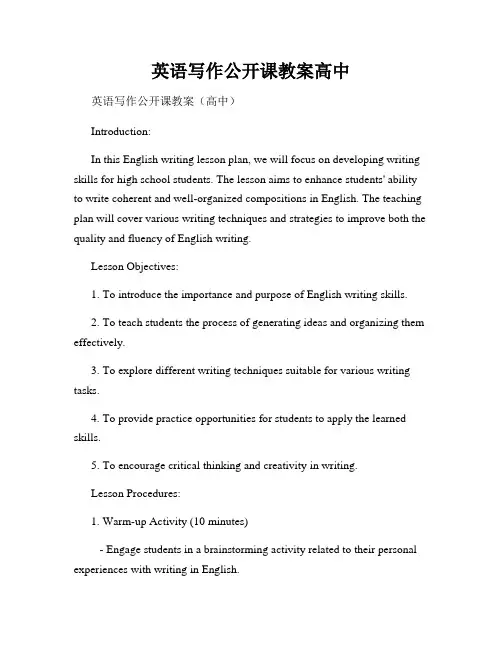
英语写作公开课教案高中英语写作公开课教案(高中)Introduction:In this English writing lesson plan, we will focus on developing writing skills for high school students. The lesson aims to enhance students' ability to write coherent and well-organized compositions in English. The teaching plan will cover various writing techniques and strategies to improve both the quality and fluency of English writing.Lesson Objectives:1. To introduce the importance and purpose of English writing skills.2. To teach students the process of generating ideas and organizing them effectively.3. To explore different writing techniques suitable for various writing tasks.4. To provide practice opportunities for students to apply the learned skills.5. To encourage critical thinking and creativity in writing.Lesson Procedures:1. Warm-up Activity (10 minutes)- Engage students in a brainstorming activity related to their personal experiences with writing in English.- Discuss the challenges they face and their goals for improving their writing skills.2. Lesson Introduction (5 minutes)- Explain the significance of English writing skills in various academic and real-life contexts.- Emphasize the importance of clear communication and coherent expression in English writing.3. Writing Process Overview (15 minutes)- Explain the step-by-step process of writing: brainstorming, outlining, drafting, revising, and editing.- Provide examples and explanations for each step.- Discuss the importance of pre-writing activities, such as free writing and mind mapping, to generate ideas.4. Writing Techniques (20 minutes)- Introduce different writing techniques: descriptive writing, persuasive writing, narrative writing, and expository writing.- Discuss the purposes and characteristics of each technique.- Provide examples and practice exercises for each technique.5. Organization and Structure (15 minutes)- Teach students how to structure an essay with an introduction, body paragraphs, and a conclusion.- Explain the importance of coherent paragraphs and transitional phrases for smooth flow and comprehension.- Provide examples and guide students through the process of organizing ideas logically.6. Grammar and Vocabulary Tips (10 minutes)- Highlight common grammar and vocabulary mistakes in English writing.- Provide tips on how to improve grammar usage and expand vocabulary effectively.- Offer supplementary resources, such as grammar checkers and vocabulary-building websites.7. Peer Review and Feedback (15 minutes)- Divide students into pairs or small groups.- Instruct them to exchange their written compositions and provide constructive feedback.- Guide students in giving feedback on content, organization, and language usage.8. Independent Writing Practice (20 minutes)- Assign a writing prompt or topic for students to independently write a composition within the given time frame.- Encourage creativity and critical thinking in their compositions.- Allow students to refer to their notes and resources as needed.9. Conclusion and Discussion (10 minutes)- Summarize the key points covered in the lesson.- Facilitate a class discussion on the challenges and improvements observed during the practice session.- Encourage students to set personal goals for continuous improvement in their writing skills.Conclusion:This English writing lesson plan for high school students provides a comprehensive guide to develop students' writing skills in different genres and styles. By focusing on the writing process, organization, grammar, and vocabulary, students will enhance their ability to express themselves coherently and effectively in written English. With regular practice and feedback, students can become confident and proficient writers.。

高中英语应用文写作提升公开课The ability to effectively communicate through written English is a crucial skill for students to develop during their high school years. High school English applied writing instruction plays a pivotal role in equipping students with the necessary tools to articulate their thoughts, ideas, and perspectives in a clear and concise manner. This public course aims to explore strategies and techniques that can be employed to enhance the quality and depth of high school English applied writing instruction.One of the fundamental aspects of improving high school English applied writing is to emphasize the importance of understanding the target audience. Students must be taught to consider the needs, interests, and expectations of their intended readers when crafting their written pieces. This involves analyzing the audience's demographic characteristics, their level of familiarity with the subject matter, and their potential biases or preconceptions. By tailoring the content, tone, and language to the audience, students can ensure that their written work resonates with the reader and effectively conveys the intended message.Another crucial element in enhancing high school English applied writing instruction is the emphasis on developing a strong organizational structure. Students should be guided through the process of planning and structuring their written work, from the introduction to the conclusion. This includes teaching them how to craft clear and coherent thesis statements, organize their ideas into logical sections or paragraphs, and use transitional phrases to seamlessly connect different ideas. By mastering the art of organization, students can create written pieces that flow smoothly and are easy for the reader to follow.In addition to audience awareness and organizational structure, high school English applied writing instruction should also focus on improving students' ability to conduct thorough research and incorporate relevant evidence into their writing. This involves teaching students how to effectively search for and evaluate credible sources, as well as how to integrate quotes, paraphrases, and citations into their work. By demonstrating the importance of supporting their claims with reliable and well-researched information, students can enhance the overall quality and persuasiveness of their written pieces.Another key aspect of enhancing high school English applied writing instruction is the emphasis on developing a strong command ofgrammar, mechanics, and style. Students should be provided with extensive practice in areas such as sentence structure, punctuation, word choice, and tone. By mastering these fundamental writing skills, students can ensure that their written work is free of errors and conveys their ideas in a clear and polished manner. Additionally, exposing students to a variety of writing styles and genres can help them develop a more nuanced understanding of how language can be used to achieve different purposes and effects.Furthermore, high school English applied writing instruction should incorporate opportunities for students to receive constructive feedback and engage in the revision process. This can be achieved through peer review activities, where students exchange their written work and provide thoughtful critiques to one another. Additionally, teachers should allocate time for students to revise and refine their writing based on the feedback received, allowing them to identify areas for improvement and make necessary adjustments. By emphasizing the importance of the revision process, students can learn to view writing as an iterative and dynamic activity, rather than a one-time task.Finally, high school English applied writing instruction should also consider the integration of technology and digital tools. In the modern era, many forms of written communication, such as emails, reports, and presentations, are increasingly being delivered throughdigital platforms. By incorporating the use of word processing software, online collaboration tools, and multimedia elements into the writing curriculum, students can develop the necessary skills to effectively navigate the digital landscape and adapt their writing to the demands of the 21st-century workplace.In conclusion, enhancing high school English applied writing instruction is a multifaceted endeavor that requires a comprehensive approach. By emphasizing the importance of audience awareness, organizational structure, research and evidence, grammar and style, feedback and revision, as well as the integration of technology, educators can empower students to become confident and competent writers. Through this public course, high school teachers can explore and implement these strategies to elevate the quality of English applied writing instruction and better prepare their students for the challenges and opportunities that lie ahead.。
高中英语应用文公开课
一、教学目标:
1. 让学生掌握常见应用文的写作格式和技巧。
2. 提高学生应用文写作的实际能力。
3. 通过公开课的形式,激发学生的兴趣和积极性。
二、教学内容:
1. 应用文的定义和种类。
2. 常见应用文(如邀请函、感谢信、道歉信、通知等)的写作格式和技巧。
3. 实际案例分析和练习。
三、教学难点与重点:
1. 难点:应用文写作的实际运用,如何根据不同情境选择合适的表达方式和语言风格。
2. 重点:写作格式和技巧的掌握,实际案例的分析和练习。
四、教具和多媒体资源:
1. 黑板或白板。
2. 投影仪,用于展示案例和范文。
3. 教学软件,如PPT或电子白板软件,用于展示教学内容和练习。
五、教学方法:
1. 激活学生的前知:通过提问或小组讨论,了解学生对应用文写作的基本认知情况。
2. 教学策略:采用讲解、示范、小组讨论、案例分析等多种教学方法,注重实际操作和互动交流。
3. 学生活动:组织学生进行小组讨论、案例分析和实际写作练习,提高他们的实际操作能力和问题解决能力。
六、教学过程:
1. 导入(5分钟):通过一个实际案例或情境导入课程,激发学生的兴趣和好奇心。
2. 讲授新课(30分钟):讲解常见应用文的写作格式和技巧,分析实际案例,引导学生了解不同应用文的写作要点和注意事项。
同时,利用多媒体资源展示范文和练习题目,帮助学生更好地理解和掌握所学知识。
在讲授过程中,注重讲解与示范相结合,让学生更好地掌握写作技巧和方法。
3. 巩固练习(20分钟):组织学生进行小组讨论和实际写作练习。
要求学生在规定时间内完成一篇应用文写作,并进行互评和讨论。
教师对学生的作品进行点评和指导,指出优点和不足之处,并给出改进建议。
通过实际操作和互动交流,提高学生的实际操作能力和问题解决能力。
4. 归纳小结(10分钟):对本节课所学内容进行总结,强调重点和难点,帮助学生加深记忆和理解。
同时,布置课后作业,要求学生完成相关的练习和复习。
5. 评估与反馈(10分钟):通过课堂表现、学生作品和课后作业等多种方式评估学生的学习效果。
及时给予学生反馈和指导,帮助他们更好地掌握应用文写作的技巧和方法。
同时,不断反思和改进教学方法和策略,提高教学质量和效果。